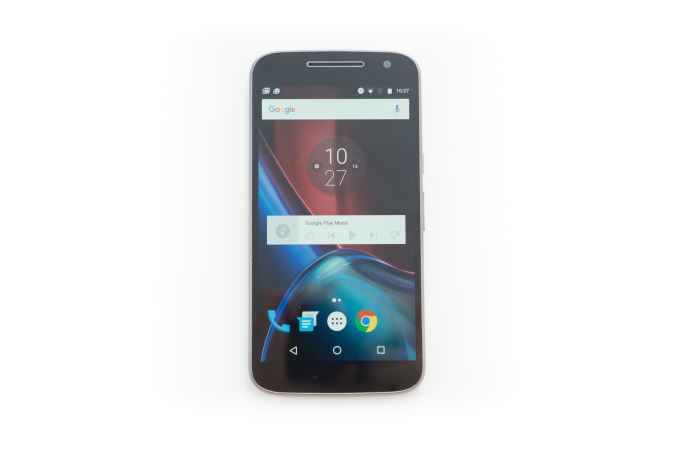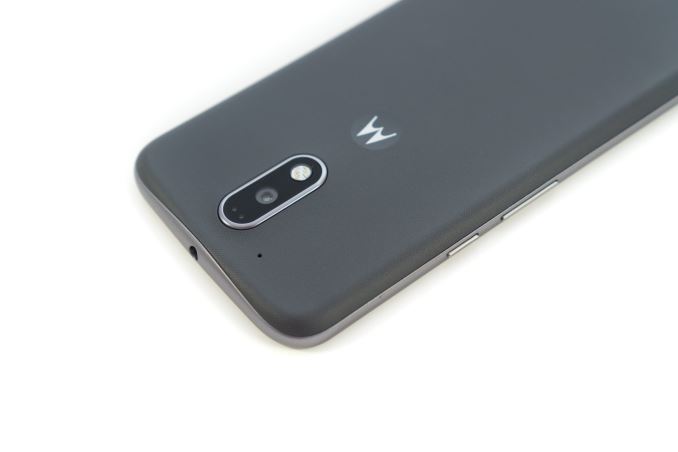The Motorola Moto G4 and G4 Plus Review
by Brandon Chester on August 15, 2016 8:00 AM EST- Posted in
- Smartphones
- Lenovo
- Motorola
- Moto G
- Moto G4
Final Words
The Moto G4 and G4 Plus represent the fourth entries in Motorola's Moto G line. For me, the Moto G has always been about balancing the different features of a smartphone to provide a well-rounded smartphone that doesn't really excel in any area, but does well in all of them. One would expect that as a product is continually developed, its quality will improve with each iteration. However, in the smartphone market there have been devices where this has not been the case. On paper, the specs of the Moto G4 and G4 Plus make them look like obvious improvements over the 2015 Moto G, but I'm not so sure that you can truly say that based on their specs alone. Over the course of this review I've looked at each aspect of the Moto G in detail, and I found that some areas impressed, while others left something to be desired. I think the question of whether or not a user should buy the Moto G4 or Moto G4 Plus is heavily dependent on what they value in a smartphone, so before trying to make any conclusions it's worth going over how each aspect of the phones compared to their predecessor.
At first glance the chassis of the Moto G4 seems to represent an upgrade over the 2015 model. It's thinner, and at least in my view the slightly rubbery feeling plastic back feels nicer than the hard plastic shell from the 2015 Moto G. However, Motorola has made a number of design decisions that I consider questionable at best. By far the worst one is the choice of buttons. I already went over this in detail in the intro, but the buttons really are terrible and the volume rocker is actually difficult to use because of it. The size of the phone also poses problems. Making the phone much larger has helped to slim it down while still putting in a large battery, but it comes at the cost of usability. I find the 2015 Moto G much easier to use due to its 5-inch display, even though it's a thicker phone and a bit more slippery in the hand due to the hardness of the back cover. The Moto G was one of the only mid-range Android devices that hadn't moved to 5.5-inches, and now there are really no options for someone looking to get a mid-range 5-inch Android smartphone.
Another strange decision is having a removable back cover just to access the SIM and MicroSD trays. This isn't something that only Motorola does, but I just don't understand why you would opt for this over removable trays when your battery isn't removable. I suppose that it simplifies the manufacturing process when the phone is ordered using Moto Maker, but you end up with an unnecessary seam between the back cover and the edges of the phone. This isn't a change from the previous Moto G, but it feels like design improvements are being left on the table. As for the Moto G4 Plus, the fingerprint scanner really feels like an afterthought, and putting it on the bottom bezel in order to keep the chassis the same between both models despite the fact that it can't be used as a home button was a really poor decision. I constantly try, and fail, to use it to return home, due in no small part to the fact that the borders are raised above the glass in such a way that you frequently feel it with your thumb. It's almost like it's inviting you to press it, but you're just greeted with failure every time you try.
My misgivings about the size aside, the Moto G4's display is actually quite good. Having two units allowed me to get an idea of what variance there is between units. It seems clear that regardless of the calibration, these displays have class leading brightness and contrast ratios, and the outdoor usability is great. Color calibration ranges from just okay to good, and it's clear that the displays target the sRGB gamut but don't really have a standard about what the white point should be or how high errors can be before they're not acceptable. In this case, the Moto G4 Plus exhibited greater accuracy, but I wouldn't attribute this to anything more than panel variance. Even if both displays had the error levels of the normal Moto G4 results, I would still say that the display is one of the best I've seen on a phone of this price.
The Moto G4's performance hasn't impressed me in any respect. Moving from Snapdragon 410 to 617 has very little impact on the CPU performance results. The GPU performance improvement is significant, but in the face of current and upcoming mid-range smartphones that use Snapdragon 650, the performance improvement going from the 2015 Moto G to the Moto G4 simply isn't large enough. We're already in the third quarter of 2016, and $200 phones with Snapdragon 615 launched in late 2015 and early 2016. Cortex A53 just doesn't provide compelling performance when competing phones are moving to an SoC with Cortex A72 cores, and Adreno 405 is only half as fast as Adreno 510.
The performance issues aren't just limited to benchmarks. Motorola's previous phones provided a smooth experience despite their limited specifications, and the Moto G4 and G4 Plus are significantly jankier throughout the UI, with even the simplest of ListViews stuttering at times. This is most certainly an issue of software rather than hardware, and stability issues with tests like PCMark battery don't inspire any confidence in the Moto G4's software quality either. Couple that with Motorola refusing to commit to monthly security updates and there's a lot of reason to be concerned about whether the Moto G4 is ever going to get to a state where it's performant and secure.
The standard Moto G4 isn't really interesting as far as camera quality is concerned because it shares a sensor with the 2015 Moto G. It makes some improvements to image quality due to the newer ISP and some altered image processing algorithms, but in general it's fair to say that the Moto G4 has just kept camera quality at the same level as its predecessor. That is to say, you can use it for daytime shots and some occasional video recording, but you won't want to take any low-light photos with it.
The Moto G4 Plus is a completely different story. One would normally not expect that a $50 upgrade comes with a significantly larger camera sensor than the base model, but that's what Motorola has done. The OV16860 sensor in the Moto G4 Plus is actually larger than some flagship smartphones, and with that comes a large improvement in low-light image quality. You also get PDAF and Laser AF, which makes focusing quick in any scenario. I do think the addition of Laser AF is questionable when the money could have been spent on improving other parts of the phone, but it does mean that you can focus effectively in low light. As far as $200-300 smartphones go I don't think there's anything that competes with the Moto G4 Plus, and if you're someone who likes taking photos and wants to buy the Moto G4 it will probably be worth paying the $50 to get the better camera.
Perhaps the most important aspect of a smartphone is its battery life. Unfortunately, the Moto G4's software stability problems that prevent it from completing the PCMark battery test leaves us without the complete story of battery life. Based on the web test and GFXBench test results, the Moto G4 appears to provide good battery life. This reflects my own experience when using the phones, with both generally making it through the day unless they're subjected to a heavy battery stressing app like Pokémon Go.
When I think about the Moto G4 and G4 Plus as a whole, it really seems to me that they weren't designed with the same attitude as their predecessors. There are areas where money shouldn't have been spent, and others where more money needed to be spent. The only thing that is truly great about the Moto G4 is its display, and even with that Motorola is just getting on par with what Huawei has been providing for quite some time in the Honor 5X. Everything else about the phones feels like a sidegrade at best, with the chassis feeling nicer but having terrible buttons, and the camera on the normal model not really improving in any significant way. CPU performance doesn't improve much, while competing phones will be making large gains with the move to Snapdragon 650. In the case of the Moto G4 Plus the extra $50-100 does get you a better phone, but the only upgrade that is truly significant is the camera.
Ultimately, I don't think the Moto G4 is a bad smartphone, but the Huawei Honor 5X provides an equally good experience and has been widely available since the start of the year. The Moto G4 has just arrived too late to be relevant. As we move toward the end of 2016 and into 2017, there are going to be new mid-range devices at these prices that greatly surpass the performance, camera, and build quality of the Moto G4, and even right now there are better options available.













94 Comments
View All Comments
kspirit - Monday, August 15, 2016 - link
The fingerprint scanner on the front ruins the look with the bottom bezel... They should have placed it on the back. Otherwise seem like pretty good phones for the price. Hopefully Moto keeps them updated instead of what they've been doing with their last few devices.nevertell - Monday, August 15, 2016 - link
Do you enjoy not being able to unlock a phone whilst it's laying on a table, screen facing upwards ?I certainly don't.
smartthanyou - Monday, August 15, 2016 - link
Seems a pretty simple thing to just pick it up and unlock. If it is a place you frequent such as work or home, you can set it up to automatically unlock.mrochester - Monday, August 15, 2016 - link
How do you get it to only unlock when it's you who is using the phone?snowmyr - Wednesday, August 17, 2016 - link
Try the fingerprint sensor.markiz - Monday, August 15, 2016 - link
This is something that is painfully obvious to me, so my I am really, really confused when people insist that fps on the back is better.johnsonx - Monday, August 15, 2016 - link
I have the ZTE ZMax Pro, which is a very similar phone to the G4 Plus, but the fingerprint sensor is on the back. I almost always pick up the phone to do anything with it, and having the fingerprint sensor on the back is natural. However it does also have numerous secondary unlock methods, several of which work without picking up the phone. Presumably the G4 Plus has similar features.Cod3rror - Monday, August 15, 2016 - link
Agreed. The back where the dimple is seemed like the obvious choice where the FP sensor would go.markiz - Monday, August 15, 2016 - link
Again, you have no problem with having to pick up the phone ALL the time?Cod3rror - Monday, August 15, 2016 - link
How often you use your phone when it's on its back compared to holding it in your hand? Most people pick up their phones purely as a habit now.